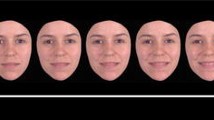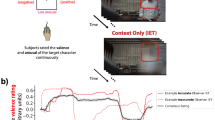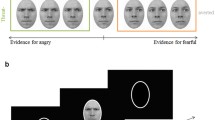Abstract
This study compared emotion perception accuracy between children with Asperger’s syndrome (AS) and high-functioning autism (HFA). Thirty children were diagnosed with AS or HFA based on empirically supported diagnostic criteria and administered an emotion perception test consisting of facial expressions and tone of voice cues that varied in intensity. Participants with AS and the typically developing standardization sample of the emotion perception instrument had the same mean emotion perception accuracy, whereas participants with HFA performed significantly worse. Results also provided preliminary evidence for a difference in accuracy perceiving low-intensity tone of voice cues between participants with HFA and AS. Future research to build on these initial findings should include attention to tone of voice, underlying processing, and cue intensity.

Similar content being viewed by others
References
Achenbach, T. M., & Rescorla, L. A. (2001). Manual for the ASEBA school-age forms and profiles. Burlington, VT: University of Vermont, Research Center for Children, Youth, & Famlies.
Adolphs, R., Sears, L., & Piven, J. (2001). Abnormal processing of social information from faces in autism. Journal of Cognitive Neuroscience, 13, 232–240.
American Psychiatric Association (2000). Diagnostic and statistical manual of mental disorders– (4th ed Text Revision). Washington, DC: Author.
Asperger, H. (1944). Die “Autistischen Psychopathen” im Kindesalter. Archiv fur Psychiatrie und Nervenkrankheiten, 117, 76–136.
Baron-Cohen, S., Wheelwright, S., & Jolliffe, T. (1997). Is there a “Language of the Eyes”? Evidence from normal adults, and adults with autism or Asperger syndrome. Visual Cognition, 4, 311–331.
Baum, K. M., & Nowicki, S. (1998). Perception of emotion: Measuring decoding accuracy of adult prosodic cues varying intensity. Journal of Nonverbal Behavior, 89, 89–107.
Braverman, M., Fein, D., Lucci, D., & Waterhouse, L. (1989). Affect comprehension in children with pervasive developmental disorders. Journal of Autism & Developmental Disorders, 19, 301–316.
Brown, J. R., & Dunn, J. (1996). Continuities in emotion understanding from three to six years. Child Development, 67, 789–802.
Bruininks, R. H., Woodcock, R. W., Weatherman, R. F., & Hill, B. K. (1996). Scales of independent behavior-revised: comprehensive manual. Chicago, IL: Riverside Publishing Company.
Cohen, J., Cohen, P., West, S. G., & Aiken, L. S. (2003). Applied multiple regression/correlation analysis for the behavioral sciences (3rd ed.). Mahwah, NJ: Lawrence Erlbaum Associates, Publishers.
Denham, S. A. (1998). Emotional development in young children. New York: Guilford Press.
Deruelle, C., Rondan, C., Gepner, B., & Tardif, C. (2004). Spatial frequency and face processing in children with autism and Asperger syndrome. Journal of Autism and Developmental Disorders, 34, 199–210. .
Eckman, P., Friesen, W. V., & Ellsworth, P. (1972). Emotion in the human face. New York: Pergamon Press.
Fein, D., Lucci, D., Braverman, M., & Waterhouse, L. (1992). Comprehension of affect in context in children with Pervasive Developmental Disorders. Journal of Child Psychiatry and Psychology, 33, 1157–1167.
Hobson, R. P. (1986a). The autistic child’s appraisal of expressions of emotion. Journal of Child Psychology and Psychiatry, 27, 321–342.
Hobson, R. P. (1986b). The autistic child’s appraisal of expressions of emotion: A further study. Journal of Child Psychology and Psychiatry, 27, 671–680.
Hobson, R. P, Ouston, J., & Lee, A. (1989). Naming emotion in faces and voices: Abilities and disabilities in autism and mental retardation. British Journal of Developmental Psychology, 7, 237–250.
Izard, C. E. (1972). The face of emotion. New York: Appelton-Century-Crofts.
Izard, C. E. (1977). Human emotions. New York: Plenum Press.
Klin, A., Jones, W., Schultz, R., Volkmar, F., & Cohen, D. (2002). Defining and quantifying the social phenotype in autism. American Journal of Psychiatry, 159, 895–908.
Klin, A., Pauls, D., Schultz, R., & Volkmar, F. (2005). Three diagnostic approaches to Asperger syndrome: Implications for research. Journal of Autism and Developmental Disorders, 35, 221–234.
Koning, C., & Magill-Evans, J. (2001). Social and language skills in adolescent boys with Asperger syndrome. Autism, 5, 23–36.
Lord, C., Storoschuck, S., Rutter, M., & Pickles, A. (1993). Using the ADI-R to diagnose autism in preschool children. Infant Mental Health Journal, 14, 234–252.
Lord, C., Risi, S., Lambrecht, L., Cook, E. H., Leventhal, B. L., et al. (2000). The Autism Diagnostic Observation Schedule-Generic: A standard measure of social and communication deficits associated with the spectrum of autism. Journal of Autism and Developmental Disorders, 30, 205–223.
Lord, C., Rutter, M., & Couteur, A. L. (1994). Autism Diagnostic Interview-Revised: A revised version of the diagnostic interview for caregivers of individuals with possible pervasive developmental disorders. Journal of Autism and Developmental Disorders, 24, 659–685.
Macintosh, K. E., & Dissanayake, C. (2004). Annotation: The similarities and differences between autistic disorder and Asperger’s disorder: A review of the empirical evidence. Journal of Child Psychology and Psychiatry, 45, 421–434.
Macdonald, H., Rutter, M., Howlin, P., Rios, P., Le Conteur, A., Evered, C., & Folstein, S. (1989). Recognition and expression of emotional cues by autistic and normal adults. Journal of Child Psychology and Psychiatry, 30, 865–877.
Mattron, L. (2004). Matching strategies in cognitive research with individuals with high-functioning autism: Current practices, instrument biases, and recommendations. Journal of Autism and Developmental Disorders, 34, 19–27.
Miller, G. M. (2001). Misunderstanding analysis of covariance. Journal of Abnormal Psychology, 110, 40–48.
Nijiokiktjien, C., Verschoor, A., de Sonneville, L., Huyser, C., Op het Veld, V., Toorenaar, N. (2001). Disordered recognition of facial identity and emotions in three Asperger type autists. European Child and Adolescent Psychiatry, 10, 79–90.
Nowicki, S. (2003). Manual for the receptive tests of the diagnosticanalysis of nonverbal accuracy 2. Unpublished manual.
Nowicki, S., & Carton, J. (1993). The measurement of emotional intensity from facial expressions. The Journal of Social Psychology, 133, 749–750.
Nowicki, S., & Duke, M. P. (1992). The association of children’s nonverbal decoding abilities with their popularity, locus of control, and academic achievement. Journal of Genetic Psychology, 153, 385–391.
Ross, D. C., & Klein, D. F. (1988). Group mating: Is this a research technique to be avoided? Educational and Psychological Measurement, 48, 281–295.
Schopler, E., Mesibov, G. B., & Kunce, L. J. (1998). Asperger syndrome or HFA. Current Issues in Autism Series. New York: Plenum Press.
Serra, M., Minderaa, R. B., van Geert, P. L. C., & Jackson, A. E. (1999). Social-cognitive abilities in children with lesser variants of autism: Skill deficits or failure to apply skills? European Child & Adolescent Psychiatry, 8, 301–311.
Smith-Myles, B., & Simpson, R. L. (2002). Asperger syndrome: An overview of characteristics. Focus on Autism and Other Developmental Disabilities, 17, 132–137.
Tantam, D., Monaghan, L., Nicholson, H., & Stirling, J. (1989). Autistic children’s ability to interpret faces: A research note. Journal of Child Psychology and Psychiatry, 30, 623–630.
Volkmar, F. R., & Klin, A. (1996). Yale special interests survey. Unpublished questionnaire.
Volkmar, F. R., Klin, A., Schultz, R. T., Rubin, E., & Bronen, R. (2000). Asperger’s disorder. American Journal of Psychiatry, 157, 262–267.
Wechsler, D. (1991). Manual for the Wechsler intelligence scale for children (3rd ed.). San Antonio: The Psychological Corporation.
Wing, L. (1981). Asperger’s syndrome: A clinical account. Psychological Medicine, 11, 115–129.
Acknowledgements
This manuscript is based on the doctoral dissertation of the first author and the manuscript version was supported by a National Research Service Award from the National Institutes of Health, T32 MH-20030 (PI MC Neale). The authors would like to thank the children and their families who participated in the study. The authors are also grateful to Ami Klin and his colleagues at Yale University for providing us with their new diagnostic criteria prior to publication, and for their consultation. We gratefully acknowledge the contributions of Dr. Albert Farrell, dissertation co-chair who provided guidance throughout the project, and Hanan Abed, for her assistance with data collection and entry. Finally, we would like to thank the reviewers for their thoughtful comments and suggestions.
Author information
Authors and Affiliations
Corresponding author
Rights and permissions
About this article
Cite this article
Mazefsky, C.A., Oswald, D.P. Emotion Perception in Asperger’s Syndrome and High-functioning Autism: The Importance of Diagnostic Criteria and Cue Intensity. J Autism Dev Disord 37, 1086–1095 (2007). https://doi.org/10.1007/s10803-006-0251-6
Published:
Issue Date:
DOI: https://doi.org/10.1007/s10803-006-0251-6




